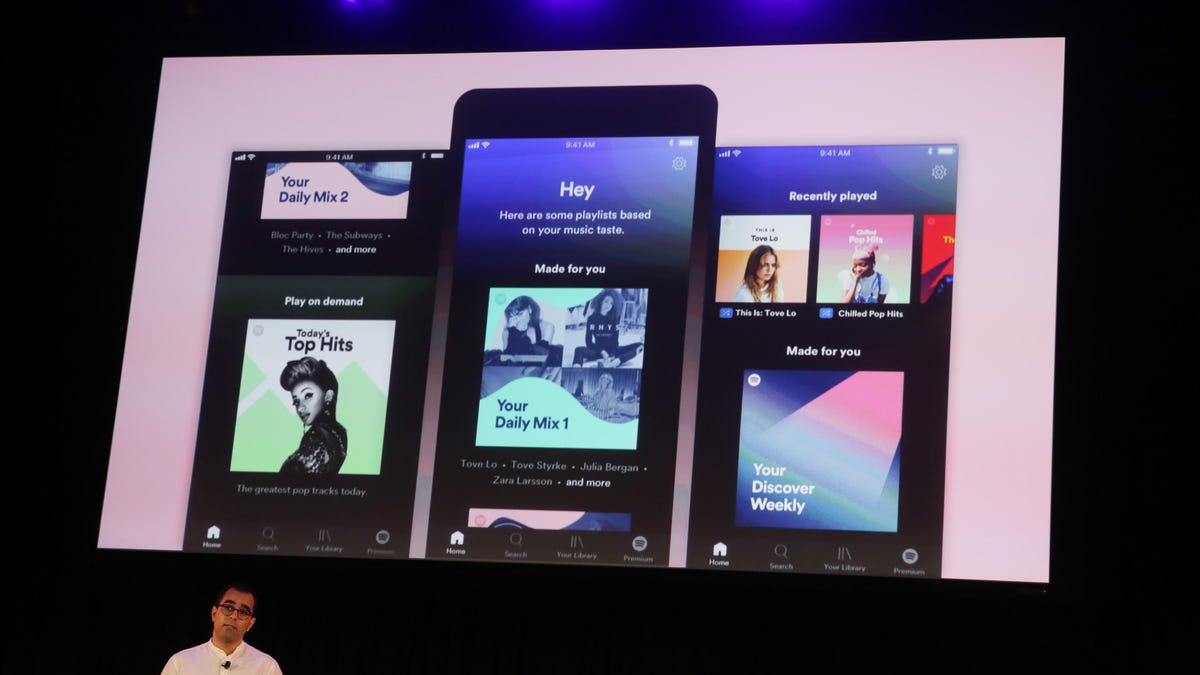Spotify's free tier has side benefit: Smarter recommendations
Unlocking on-demand listening for free users means that the songs Spotify picks for you will hit closer to the bull's-eye.

Babar Zafar, Spotify's VP of product development, demoed the streaming-music service's new free tier in New York this week.
Spotify's revamped mobile app unshackles free users from shuffle mode -- and opens up a cache of new data in the process.
The world's largest music-streaming service said Tuesday that after years of limiting mobile users of its free tier to shuffled songs, it's opening up about 40 hours of on-demand music from 15 playlists like your personalized Discover Weekly mix and popular curated playlists like RapCaviar.
That's cause for all cheapskate music fans to rejoice, but the move has a hidden side effect. Most of Spotify's listening happens on a mobile device, and most of its listeners are streaming without paying. By opening up that giant population to a bigger playground of music, Spotify is triggering a bumper crop of data about how to make the best music recommendations for everyone's individual taste, including yours.
"All of this ... understanding of music was locked into Premium," Babar Zafar, Spotify's vice president of product development, said in an interview Tuesday. "What happens when you add another 90 million users?"
With 71 million paying members and almost 90 million free users who stream at least once a month, Spotify's scale has made it a major force in a larger cultural shift in listening to music. After decades of buying music outright -- whether through records, tapes, CDs or digital downloads -- the explosive popularity of services such as Spotify and Apple Music mean people are increasingly paying flat fees for all-you-can-access tunes.
The model opens up listeners to a vast catalog with tens of millions of songs. But it also creates a dilemma for companies figuring out how to suit consumers' specific tastes as their listening habits change. A digital download library, packed with music that you already cared about enough to buy, is simple to just shuffle and play. Tapping this extra data could give Spotify an edge as it seeks to maintain its lead over fast-growing Apple Music, which boasts 40 million subscribers, as well as other services such as Pandora and Amazon Prime Music.
Russ Crupnick, managing partner at market researcher MusicWatch, said music-streaming services are all data-driven companies. The more data one company gets, the more of an edge it has over the competition. And people who use Spotify's free tier are less likely to be the kind of proactive music aficionados who fervently craft perfected playlists of their own.
"From a sample of one, all the things that I create I get tired of in a week. I want my music service to give me good recommendations," he said. "When people get tired, that's when they stop using it."
The popularity of Spotify's playlists is big and growing. About 31 percent of everything people listen to on Spotify comes via playlists. Those include curated playlists, such as RapCaviar, Viva Latino and Ultimate Indie, or personalized algorithmic playlists, such as Discover Weekly, Daily Mix and Release Radar. The figure was less than 20 percent two years ago.
"Three years ago, everybody was listening to playlists that either they made or friends made," BTIG Research analyst Rich Greenfield said. "The key is can [Spotify] transform playlists from just lists of music to must-have consumer brands?"
Spotify's taking a stab: RapCaviar, sometimes referred to as the "most influential playlist in music," moved offline into the real world with a self-titled concert series last year.
Spotify's expanded data collection on the new free tier will most directly affect purely algorithmic lists like Discover Weekly. But widened data will strengthen human-curated playlists like RapCaviar, too. The programmers behind lists are genre experts who use Spotify's data as well as their gut instincts and trained ears. Tuma Basa, Spotify's former head of hip-hop programming and the Svengali behind RapCaviar, has said he crunches numbers to compile the list. Factors he considers include the number of times a song or artist is searched and the percentage of people who skip the song.
With nearly 100 million more people searching and skipping, Spotify will soon have even more clues that'll tell it exactly what to play for you.
The Smartest Stuff: Innovators are thinking up new ways to make you, and the things around you, smarter.
Tech Culture: From film and television to social media and games, here's your place for the lighter side of tech.

